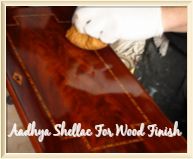Wood finishing refers to the
process of refining or protecting a wooden surface, especially in the
production of furniture where typically it represents between 5 and 30% of
manufacturing costs.
Finishing is the final step of
the manufacturing process that gives wood surfaces desirable characteristics,
including enhanced appearance and increased resistance to moisture and other
environmental agents. Finishing can also make wood easier to clean and
influence other wood properties, In addition, finishing provides a way of
giving low-value woods the appearance of ones that are expensive and difficult
to obtain.
|
Appearance |
Protection
|
Durability
|
Safety
|
Ease
of Application
|
Reversibility
|
Rubbing
Qualities
|
||
|
From
virtually clear (super blond) to a rich orange (garnet)
|
Fair
against water, poor solvent protection
|
Durable
|
Safe
when solvent evaporates, used as food and pill coating
|
Clogs
spray equipment. Quick solvent flash time makes brushing difficult. Ox or
badger/skunk hair brush recommended. Easy to pad, however French Polish is
difficult
|
Completely
reversible using alcohol
|
Excellent
|
||























































